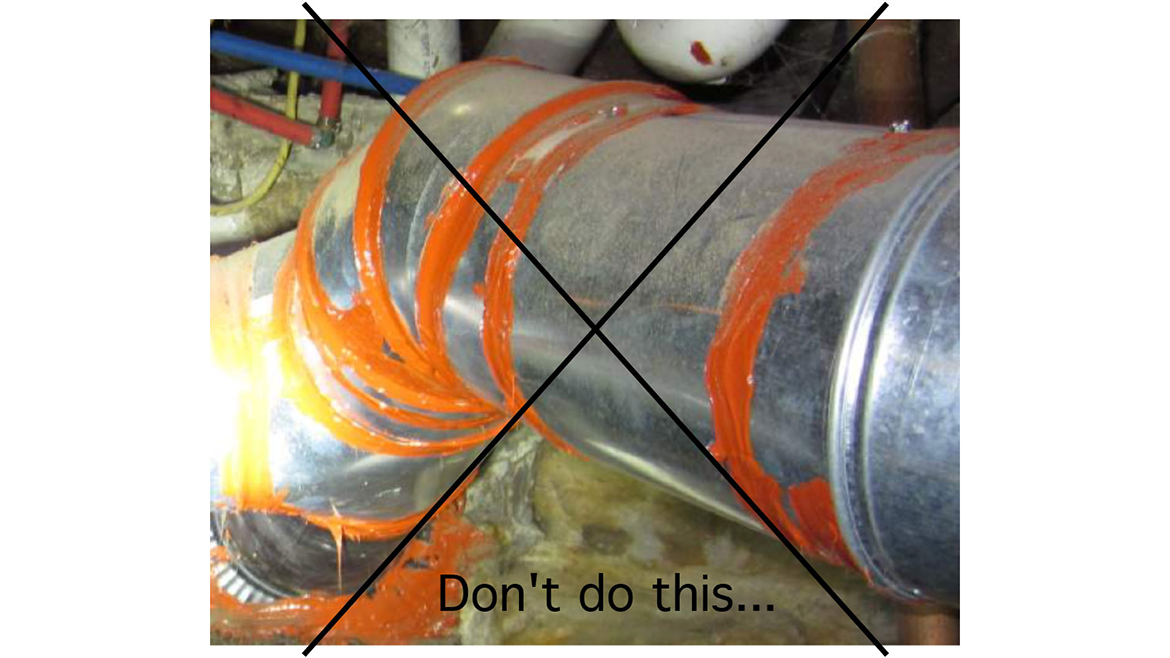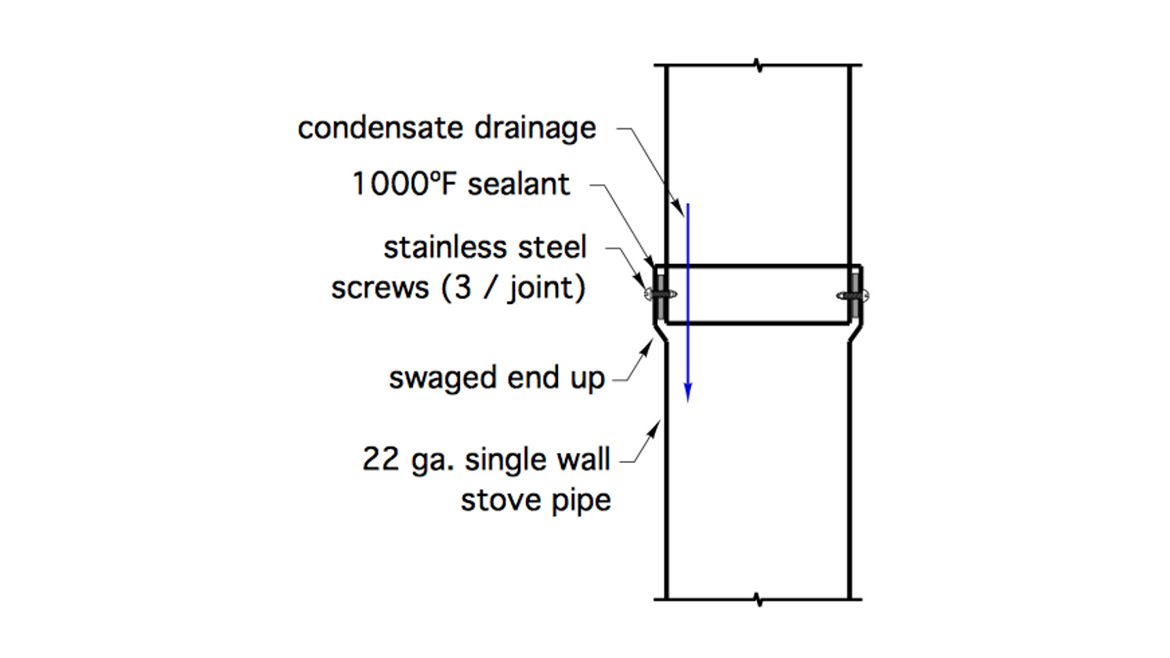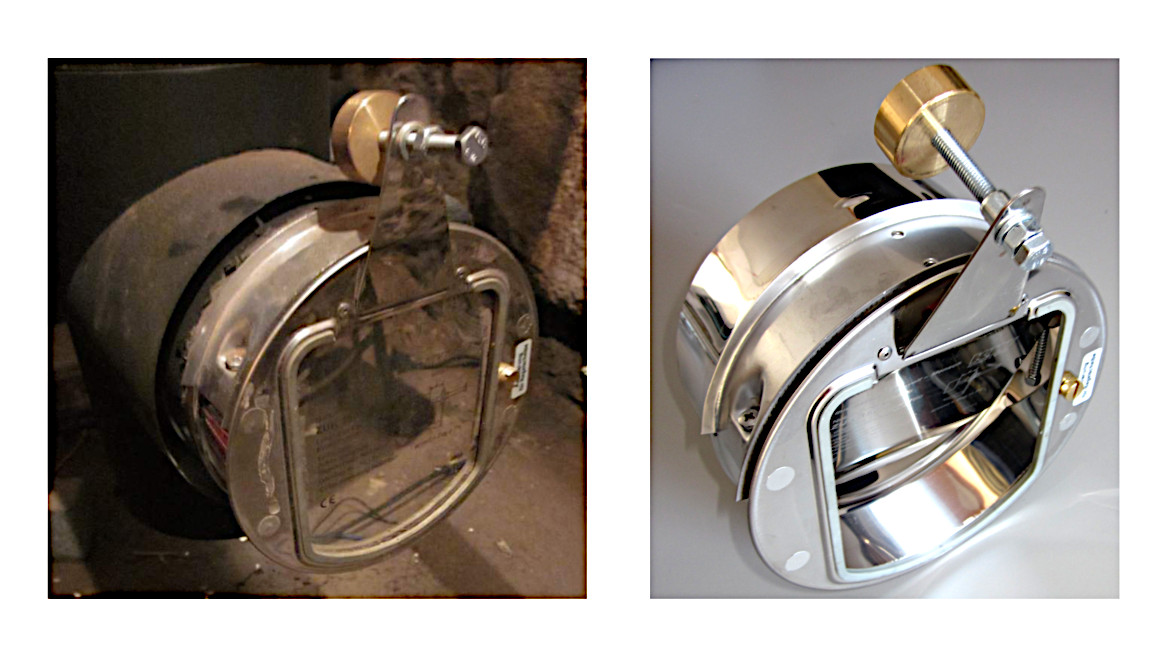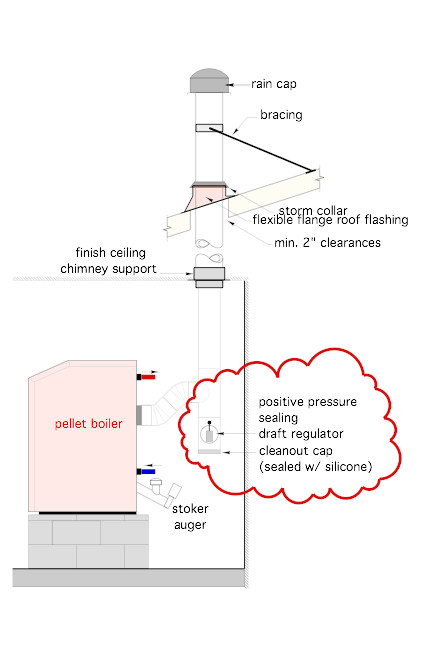
(Left) Figure 1a, (Middle) Figure 1b, (Right) Figure 1c
The Glitch & The Fix: Preventing fly ash accumulation
The Glitch:
Take a look at the vent connector piping shown in Figures 1a, 1b and 1c. These photos were all taken at pellet boiler installations. Do you see something in common? What’s the issue and what can be done to resolve it?
The Issues:
Modern pellet-fueled boilers are sophisticated devices. Most of them have an internal draft-inducing blower. The speed of that blower is regulated based on the oxygen content of the flue gases. This allows the boiler to adjust the excess air supplied to the combustion chamber to maintain optimal combustion efficiency.
Properly configured pellet boiler systems incorporate thermal storage, and should only require the boiler to fire for 2 to 3 times on a typical winter day. This implies that there will be several hours when no flue gases are passing up the chimney. The chimney will cool off during those times.
In situations where a modern pellet-fired boiler is combined with a “cold” chimney, the flue gas flow created by the boiler’s inducer blower at startup can be higher than the initial drafting ability of the chimney. The result is slight positive pressure in the vent connector piping. The flue gases and any small amount of fly ash present in the exhaust stream will find any exit point in the vent connector piping assembly. That’s why you see the ash accumulating on the outside of the vent connector joints and draft regulator in Figure 1. This condition is especially problematic with an exterior masonry chimney due to its high thermal mass. Following a cold start on a winter day, that type of chimney can take a while to establish a good draft.
The Fixes
Several details can improve or eliminate the ejection of flue gases and ash from pellets boiler venting systems.
First, whenever possible use a UL-103HT rated stainless steel prefabricated chimney, and route it up through as much heated space as possible on its way to the roof. Prefab chimneys have much less thermal mass compared to masonry chimneys. They can establish a draft much faster when starting from a cold condition. When routed up through conditioned space, these chimneys have a “head start” on warming up to establish proper draft.
If an existing masonry chimney will be used, install a stainless steel liner and insulate between the liner and existing chimney flue with approved materials and in conformance with local codes.
Second, all vent connectors should be made of seamless single-wall or double-wall pipe. Don’t use standard galvanized “snap seam” pipe. Remember that positive pressure within the pipe will find any and all paths to the outside. That snap seam is not sealed and it will leak.
Third, use a high-temperature sealant on all joints, and apply it correctly. Don’t smear RTV silicone on the outside of the joints — as shown in Figure 2.
Figure 2


This looks very unprofessional, and in most cases, the RTV silicone will eventually lose contact with galvanized piping due to dust or oil films created during manufacturing, handling or installation.
Sealants such as Mill-Pac Black are used to seal components on wood stoves, and are rated to withstand temperatures of about 1000° F (which is much higher than should normally occur in vent connector piping from a pellet-fired boiler). Place the sealant inside the swaged joint of the pipe as shown in Figure 3. When single-wall pipe is used, be sure to use stainless steel fasteners at all joints in the piping.
Figure 3


On the wish list
One final detail that our European counterparts commonly use is a draft regulator that can seal against positive pressure inside the vent connector piping. An example of such a regulator is shown in Figure 4.
Figure 4


When positive pressure occurs inside the vent piping, the rotating plate of this regulator is pressed against a gasket. The greater the internal pressure the better the seal. The regulator is constructed of stainless steel and has an adjustable brass counterbalance to control the negative pressure at which the plate opens. In my opinion, this is the “Rolex” of draft regulators.
Unfortunately, this regulator doesn’t currently have a UL rating, (which may or may not be required by various codes). Given our government’s current penchant for eliminating combustion-based heating, chances are not good for getting the European manufacturer of this regulator to jump through the hoops and cost to get that UL rating. I hope I’m wrong on this. I would love to see this product available in the U.S.
Drop leg
Another venting detail that is used in Europe is to place the draft regulator slightly lower than the sloping vent connector pipe as shown in Figure 5.
Figure 5


This keeps the draft regulator below the flue gas stream, and thus more removed from any fly ash entrained with the flue gases. A removable cap seals the bottom of the tee into which the regulator is mounted. The cap acts as a catch basin for a small amount of fly ash. It can be easily removed once each season to dump the ash.